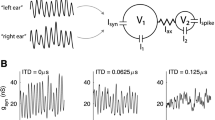Abstract
We introduce a biologically inspired azimuthal sound localisation system, which simulates the functional organisation of the human auditory midbrain up to the inferior colliculus (IC). Supported by recent neurophysiological studies on the role of the IC and superior olivary complex (SOC) in sound processing, our system models two ascending pathways of the auditory midbrain: the ITD (Interaural Time Difference) pathway and ILD (Interaural Level Difference) pathway. In our approach to modelling the ITD pathway, we take into account Yin’s finding that only a single delay line exists in the ITD processing from cochlea to SOC for the ipsilateral ear while multiple delay lines exists for the contralateral ear. The ILD pathway is modelled without varied delay lines because of neurophysiological evidence that indicates the delays along that pathway are minimal and constant. Level-locking auditory neurons are introduced for the ILD pathway network to encode sound amplitude into spike sequence, that are similar to the phase-locking auditory neurons which encode time information to the ITD pathway. A leaky integrate-and-fire spiking neural model is adapted to simulate the neurons in the SOC that process ITD and ILD. Experimental results show that our model performs sound localisation that approaches biological performance. Our approach brings not only new insight into the brain mechanism of the auditory system, but also demonstrates a practical application of sound localisation for mobile robots.
Preview
Unable to display preview. Download preview PDF.
Similar content being viewed by others
References
Oertel, D., Fay, R., Popper, A. (eds.): Integrative Functions in the Mammalian Auditory Pathway. Springer, New York (2002)
Young, E., Davis, K.: Circuitry and Function of the Dorsal Cochlear Nucleus. In: Integrative Functions in the Mammalian Auditory Pathway, pp. 160–206. Springer, New York (2002)
Fitzpatrick, D., Kuwada, S., Batra, R.: Transformations in processing interaural time differences between the superior olivary complex and inferior colliculus: Beyond the jeffress model. Hear. Res. 168(1-2), 79–89 (2002)
Jeffress, L.: A place theory of sound localization. J. Comp. Physiol. Psychol. 61, 468–486 (1948)
Smith, P., Joris, P., Yin, T.: Projections of physiologically characterized spherical bushy cell axons from the cochlear nucleus of the cat: evidence for delay lines to the medial suprior olive. J. Comp. Neurol. 331, 245–260 (1993)
Hirsch, J.A., Chan, J.C., Yin, T.C.: Responses of neurons in the cat’s superior colliculus to acoustic stimuli. i. monaural and binaural response properties. J. Neurophysiol. 53, 726–745 (1985)
Yin, T.: Neural mechanisms of encoding binaural localization cues in the auditory brainstem. Integrative Functions in the Mammalian Auditory Pathway, 99–159 (2002)
Gerstner, W., Kistler, W.M.: Spiking Neuron Models, Single Neurons, Populations, Plasticity. Cambridge Unviersity Press, Cambridge (2002)
Voutsas, K., Adamy, J.: A biologically inspired spiking neural network for sound source lateralization. IEEE Trans Neural Networks 18(6), 1785–1799 (2007)
Meddis, R., Hewitt, M., Shackleton, T.: Implementation details of a computation model of the inner hair-cell/auditory-nerve synapse. J. Acoust. Soc. Am. 87(4), 1813–1816 (1990)
Author information
Authors and Affiliations
Editor information
Rights and permissions
Copyright information
© 2008 Springer-Verlag Berlin Heidelberg
About this paper
Cite this paper
Liu, J., Erwin, H., Wermter, S., Elsaid, M. (2008). A Biologically Inspired Spiking Neural Network for Sound Localisation by the Inferior Colliculus. In: Kůrková, V., Neruda, R., Koutník, J. (eds) Artificial Neural Networks - ICANN 2008. ICANN 2008. Lecture Notes in Computer Science, vol 5164. Springer, Berlin, Heidelberg. https://doi.org/10.1007/978-3-540-87559-8_41
Download citation
DOI: https://doi.org/10.1007/978-3-540-87559-8_41
Publisher Name: Springer, Berlin, Heidelberg
Print ISBN: 978-3-540-87558-1
Online ISBN: 978-3-540-87559-8
eBook Packages: Computer ScienceComputer Science (R0)




